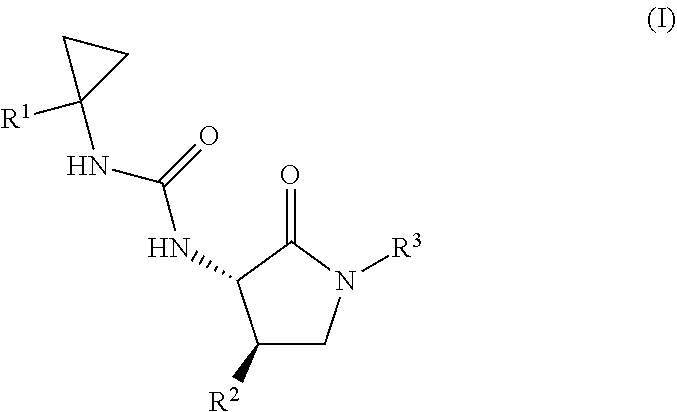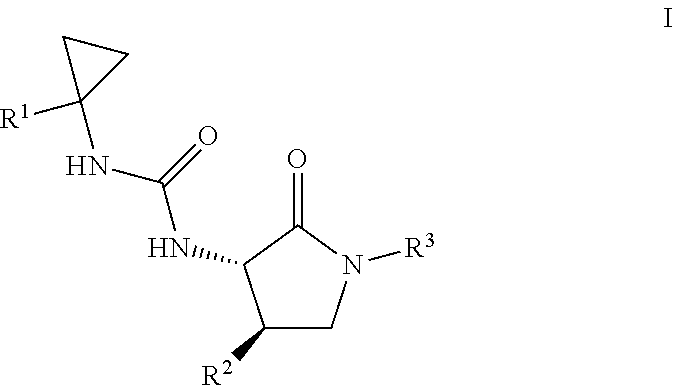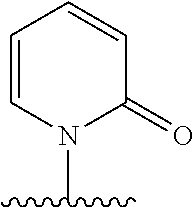Cyclopropyl urea formyl peptide 2 receptor and formyl peptide 1 receptor agonists
a technology of cyclopropyl urea and formyl peptides, which is applied in the direction of drug compositions, cardiovascular disorders, organic chemistry, etc., can solve the problems of progressive loss of heart function and scar formation
- Summary
- Abstract
- Description
- Claims
- Application Information
AI Technical Summary
Benefits of technology
Problems solved by technology
Method used
Image
Examples
example 1.3
Example 1. 3-[1-(6-chloropyridin-2-yl)cyclopropyl]-1-[(3S,4R)-4-(2,6-difluoro-4-methoxyphenyl)-2-oxopyrrolidin-3-yl]urea
[0076]
A mixture of 1-(6-chloropyridin-2-yl)cyclopropanamine, HCl (36.6 mg, 0.178 mmol) and Intermediate 2 (30.0 mg, 0.0890 mmol) in DMF (0.5 mL) were stirred overnight in DMF (0.5 mL) at 60° C. Purification by RP HPLC provided the title compound (25.9 mg, 67%) MS (ESI) m / z 437.3 (M+H). 1NMR (500 MHz, DMSO-d6) δ 7.94 (br. s., 1H), 7.66 (t, J=7.7 Hz, 1H), 7.23-7.12 (m, 2H), 7.02 (br. s., 1H), 6.73 (d, J=10.9 Hz, 2H), 6.41 (d, J=8.4 Hz, 1H), 4.44 (t, J=9.0 Hz, 1H), 3.74 (m, 4H), 3.52-3.32 (m, 1H), 3.32-3.22 (m, 1H), 1.33 (br. s., 2H), 1.09 (br. s., 2H). Analytical HPLC retention time: 1.38 min (Method B).
example 2.1
Example 2. 1-[(3S,4R)-4-(2,6-difluoro-4-methoxyphenyl)-2-oxopyrrolidin-3-yl]-3-[1-(4-methylphenyl)cyclopropyl]urea
[0077]
2A. 1-(p-tolyl)cyclopropanamine
[0078]
To a suspension of 1-(p-tolyl)cyclopropanecarboxylic acid (100 mg, 0.567 mmol) in DMF (0.284 mL) was added TEA (0.870 mL, 0.624 mmol) followed by dropwise addition of diphenylphosphoryl azide (0.135 mL, 0.624 mmol), and the mixture stirred ON at rt. The reaction mixture was heated to 100° C. and water (12 mL) and 1N HCl (2.5 mL) were added dropwise, and the resulting mixture stirred at 100° C. for 2 h. The reaction mixture was cooled to rt and extracted with EtOAc. The aqueous layer was neutralized with a 10% solution of sodium hydroxide to pH 10, and then extracted with ethyl acetate. The combined EtOAc extracts were washed with brine, dried over Na2SO4 and evaporated to give 2A (20 mg, 24%). MS (ESI) m / z 148 (M+H).
Example 2. Example 2 was prepared from Intermediate 2 and 2A using the procedure described for Example 1. MS (ESI)...
example 3.1
Example 3. 1-[(3S,4R)-4-(2,6-difluoro-4-methoxyphenyl)-2-oxopyrrolidin-3-yl]-3-[1-(3,5-dimethylphenyl)cyclopropyl]urea
[0079]
3A. 1-(3,5-dimethylphenyl)cyclopropanamine
[0080]
To a solution of 3,5-dimethylbenzonitrile (250 mg, 1.91 mmol) and titanium(IV) isopropoxide (0.614 mL, 2.10 mmol) in Et2O (8.74 mL) was slowly added a 3M solution of EtMgBr in Et2O (1.40 mL, 4.19 mmol) at −50° C. under nitrogen. The mixture was warmed up to rt for 1 hr. BF3.OEt2 (0.483 mL, 3.81 mmol) was then added slowly. The mixture was stirred at rt ON. The reaction was quenched by dropwise addition of −10 mL of 1N HCl. Ether (150 mL) was added to extract the aqueous layer. The organic layer was again washed with 1N HCl. The combined aqueous layers were neutralized with 10% wt NaOH to pH=12, then extracted with EtOAc. The solvent was removed to give 3A as a yellow oil (179 mg, 58%). MS (ESI) m / z 162.1 (M+H).
Example 3. Example 3 was prepared from Intermediate 2 and 3A as described for Example 1. MS (ESI) m / z 430...
PUM
| Property | Measurement | Unit |
|---|---|---|
| temperature | aaaaa | aaaaa |
| pH | aaaaa | aaaaa |
| pH | aaaaa | aaaaa |
Abstract
Description
Claims
Application Information
 Login to View More
Login to View More - R&D
- Intellectual Property
- Life Sciences
- Materials
- Tech Scout
- Unparalleled Data Quality
- Higher Quality Content
- 60% Fewer Hallucinations
Browse by: Latest US Patents, China's latest patents, Technical Efficacy Thesaurus, Application Domain, Technology Topic, Popular Technical Reports.
© 2025 PatSnap. All rights reserved.Legal|Privacy policy|Modern Slavery Act Transparency Statement|Sitemap|About US| Contact US: help@patsnap.com



